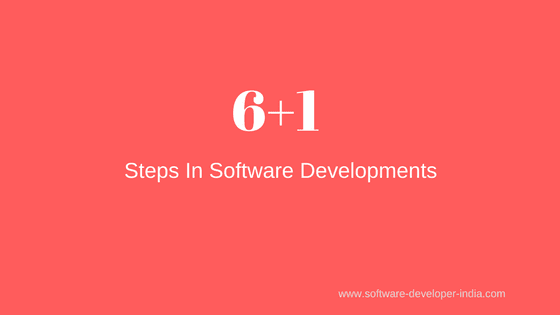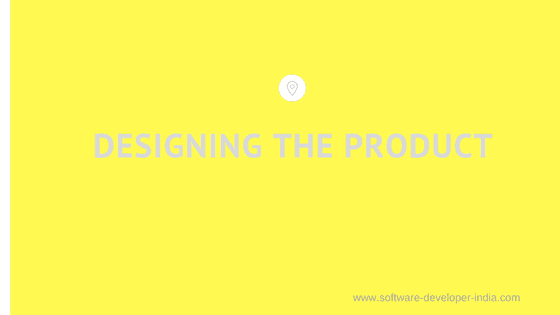The 6+1 steps in software developments

There is a process for developing software. A good software development model, if followed diligently, will help you make a great product. The chart that you see above is the fundamental structure for making a software. Following this methodical approach would actually shorten product cycles and help you release your product much before the release date. Have a look at the different steps in the software development process:
Gathering Requirements
Requirement analysis is one of the first steps in software development. It is not a fun job, but it plays an important role in helping the software team decide on where to start their process and what the customers have their hearts set on. Though first, this is a very important step because software development teams are not mind readers; they cannot come up with something desired by the customers unless it is put in black and white to them.
While gathering requirements you need to talk to as many people as possible. You might not reach 100% accuracy, but it will still help you reach somewhere. Record and take notes whenever possible.
There is a sub step in Gathering Requirements phase. It is called Feasibility Analysis step, it would help you decide how much information that has been collected earlier can be put into practicality. Don’t leave out the stakeholders here. Have a copy of the customer interviews and surveys when you are meeting with the stakeholders.
Planning a concept or an idea
Once all the information has been collected, the next step would be to plan a concept or an idea based on which the software would be developed. Here, you will also be getting the final team ready to carry out the concept and the vision. In the planning stage, you can plan on the work schedule, tools that are going to be used in developing the software, methods to use and risks that they might have to face.
Designing the product

The third step in software development is designing the product. It is here that the architecture of the software is determined, where the team ensures that all the requirements regarding the making of the product are fulfilled. It is during the “designing the product” stage that the software team will go through all the information they have collected in the first stage, the “requirement gathering” stage. It is at this stage that they will determine the target segment, the resources to be used and the time required to complete the project.
If you have observed real estate construction projects, it would come to your notice that it is the roof that is one of the first things constructed, even before the foundation has been fully designed. Similarly, the team has to build the basic structure of the software before they start coding the screens. This is because the modules of the project must link with each other seamlessly. If the screens are designed before that, there will be a mismatch somewhere, and you will have to start building all over again. As it is, the design will go have to through several iterations to ensure it conforms to business requirements.
Implementation stage
It is during the Implementation stage that the real task of developing the software is started. Here, you keep the end user of your software in mind when you go through each process of making the software. So, implementation stage is the step where the actual process of the software starts. Programmers are busy with encoding, the contractors are working on the building part and designers are up to their necks with designing the graphic material. To an outsider, this is the stage where they approve that something is really happening because they can see visual results. It is also at this phase that you devise the tools and documentations that the customer would use in the future. You will also devise the security and privacy measures of the software at the implementation stage.
The Implementation stage is deemed complete when the specifications in the first 3 stages are met and fulfilled according to plan.
Testing for bugs

At the ‘Testing for bugs’ stage, the programmers would test the code in order to check for bugs. The software will be tried and tested by certain users who will then comment on the changes that are to be made, and the occurrence of bugs, if any. This is the step where you polish your software and make it perfect.
Maintenance and Upgrading
This stage is also known as follow-up stage. It is here that you provide everything that users would need to use the software successfully. Project leaders often jokingly say that the first phase of the product comprising of about 90% of the project would finish quickly, and it is the last 10% that takes a long time to complete. If there are any errors that could clash with the upgrading of the software, it would be corrected here.
Releasing the software – Judgment Day
Once your software’s bugs are fixed, and everything in it is perfected, your software is ready for release. The release phase is also a very important step because this is where you fly off or fall down. If you had mapped out a good plan of action, you can detect any privacy and security vulnerabilities that might come your way. Hence, it is quite important to have a Final Security Review before it gets into the hands of the end user.
Conclusion
These are the 7 basic steps in software development. When you devote time and energy to perfect each step, there is no chance you could go wrong.
Interesting links about the topic:
What are the Software Development Life Cycle (SDLC) phases?
6 basic steps of software development process

The author: Reema Oamkumar is engaged as a thought leader at Software-Developer-India.com which is a part of the YUHIRO Group. YUHIRO is a German-Indian enterprise which provides programmers to IT companies, agencies and IT departments.
Leave a Reply